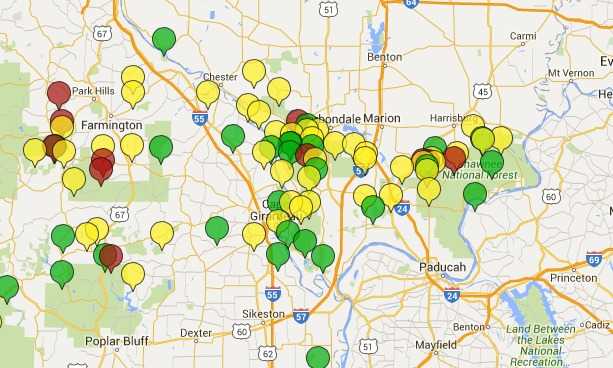
Pavement Ends
James Baughn was the webmaster of seMissourian.com and its sister newspapers for 20 years. On the side, he maintained even more sites, including Bridgehunter.com, LandmarkHunter.com, TheCapeRock.com, and Humorix. Baughn passed away in 2020 while doing one of the things he loved most: hiking in Southeast Missouri. Here is an archive of his writing about hiking and nature in our area.
More accounts of the Bloomfield Road
Posted Wednesday, February 3, 2010, at 2:48 PM
I've been invited to give a presentation Feb. 22 to the Stoddard County Historical Society in Bloomfield on the past, present, and future of the Bloomfield Road.
You can become a fan of Pavement Ends on Facebook to keep up to date on this and other upcoming events. I'm hoping to arrange some kind of daytrip event this spring when the weather improves, possibly titled the "Official Pavement Ends Daytrip Outing Featuring A Short, Easy Hike Selected For Those Of Us Who Are Out of Shape."
Back to the Bloomfield Road. Paul Corbin of Advance has written a blog describing a trip his mother made along the Bloomfield Road ca. 1904. The journey to Cape and back took three days by wagon.
Digging through the archives of the Southeast Missouri, I've found two amusing items describing the horrible condition of the Bloomfield Road during the 1920s.
Editorial from the Bloomfield newspaper
The first, from May 28, 1923, was a reprint of an editorial by the Bloomfield Vindicator complaining about the shoddy work done by road overseers which led to a major wreck on the road near Aquilla (which they spelled "Acquilla"). Here it is:
CAUSE OF AN ACCIDENT
The recent accident on the Acquilla road which might easily have cost the lives of two good men, serves to call attention to the characteristic carelessness of some of our road overseers. There are exceptions to all rules, and occasionally you find an overseer who, when a washout occurs on his section of road will go at once and make the necessary repairs, but in a majority of instances the roads are allowed to go from bad to worse until it is convenient to fix them. In this case hundreds of cars pass over the road daily. Anyone unfamiliar with the condition of the road was liable to a serious accident. It had been in a dangerous condition for weeks. A few hours work at the most would have been sufficient to make it safe for travel, but nobody seemed to care, so that we often wonder, "why is a road overseer, anyhow?" Whose duty is it to see that the roads are kept in a safe and passable condition? We think these officials are too poorly paid for the responsible work they are expected to perform. They should be paid a living wage and then held responsible for the good conditions of the roads in their districts. The highway engineer ought to shoulder some of the responsibility. If there is any excuse for the existance of the office, it ought to be to see that road officials do their duty and in case of failure report to the proper authorities. It is not to anybody's credit to have any of our highways in an unsafe condition without proper warning notices being posted so that the traveller may be advised as to their condition. We hope this may be lesson to all who have authorities over the highways. -- Bloomfield Vindicator
Letter from Giboney Houck
The second item is a sharply worded letter from Giboney Houck, published Feb. 27, 1929. During this time, the road from Dutchtown to Cape was maintained by the state -- or in this case, unmaintained. A couple years later, the state built a brand new road (Highway 74), bypassing the old Bloomfield Road. Here is what Giboney Houck wrote:
Calls Attention to Condition of Bloomfield Road
The Bloomfield road is one of the important roads leading to Cape Girardeau. For some days it has been largely impassible. Why?
It is, or was, a macadamized road, in fact one of the oldest macadamized roads in the county. Until a few years ago it was kept in a high state of efficiency. Local people took pride in it and looked after it. Along this road there came a stream of traffic to Cape Girardeau, not only from the southwest part of this county, but from Stoddard and Dunklin counties. During the autumn and winter farmers living along this road were employed to haul gravel by local road over-seers who were anxious to improve it. In this way it was nearly all graveled each year from Cape to Dutchtown.
It became one of the finest roads in the state.
After the State Highway Department was organized it wanted the Bloomfield road, so as to help it make a showing, accordingly it was turned over to the State Highway Department.
Would Maintain It.
We were told that the State Highway Department would maintain the Bloomfield road in the high state of usefulness that had always characterized it when under the control of our county officers. We were badly fooled.
Since the Highway Department took control the road has been allowed to deteriorate. Little or no gravel has been put on it. It is now almost a mud road. More than this. Some of the Highway Department money has been invested in expensive road grading machinery which has taken the place of the local farmer who with his team used to make a little money graveling the road every year. The efficient Highway Department saves money by the use of its machines manufactured in Ohio or other distant states. But our farmers, who having nothing to do at this time, and need money more than they ever did, lose the chance they once had to make a little money working the road. And the people of the city of Cape Girardeau lose the great trade southwest of here, by reason of an impassable road.
No doubt the State Highway Department has other and more important roads to look after than the Bloomfield road. However, merchants and business men in the city of Cape Girardeau must not be surprised at the absence of people from the city on a beautiful day like today (Feb. 26th) when a great road like the Bloomfield road has been so neglected as to be practically impassible.
--Giboney Houck.


Respond to this blog
Posting a comment requires a subscription.